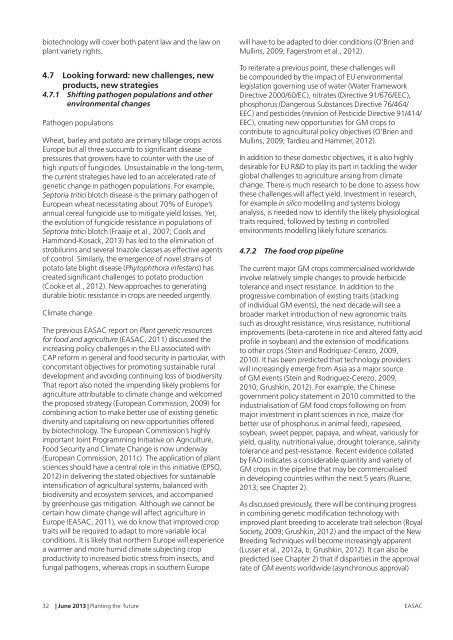Planting the future: opportunities and challenges for using ... - EASAC
Planting the future: opportunities and challenges for using ... - EASAC
Planting the future: opportunities and challenges for using ... - EASAC
Create successful ePaper yourself
Turn your PDF publications into a flip-book with our unique Google optimized e-Paper software.
iotechnology will cover both patent law <strong>and</strong> <strong>the</strong> law on<br />
plant variety rights.<br />
4.7 Looking <strong>for</strong>ward: new <strong>challenges</strong>, new<br />
products, new strategies<br />
4.7.1 Shifting pathogen populations <strong>and</strong> o<strong>the</strong>r<br />
environmental changes<br />
Pathogen populations<br />
Wheat, barley <strong>and</strong> potato are primary tillage crops across<br />
Europe but all three succumb to significant disease<br />
pressures that growers have to counter with <strong>the</strong> use of<br />
high inputs of fungicides. Unsustainable in <strong>the</strong> long-term,<br />
<strong>the</strong> current strategies have led to an accelerated rate of<br />
genetic change in pathogen populations. For example,<br />
Septoria tritici blotch disease is <strong>the</strong> primary pathogen of<br />
European wheat necessitating about 70% of Europe’s<br />
annual cereal fungicide use to mitigate yield losses. Yet,<br />
<strong>the</strong> evolution of fungicide resistance in populations of<br />
Septoria tritici blotch (Fraaije et al., 2007; Cools <strong>and</strong><br />
Hammond-Kosack, 2013) has led to <strong>the</strong> elimination of<br />
strobilurins <strong>and</strong> several triazole classes as effective agents<br />
of control. Similarly, <strong>the</strong> emergence of novel strains of<br />
potato late blight disease (Phytophthora infestans) has<br />
created significant <strong>challenges</strong> to potato production<br />
(Cooke et al., 2012). New approaches to generating<br />
durable biotic resistance in crops are needed urgently.<br />
Climate change<br />
The previous <strong>EASAC</strong> report on Plant genetic resources<br />
<strong>for</strong> food <strong>and</strong> agriculture (<strong>EASAC</strong>, 2011) discussed <strong>the</strong><br />
increasing policy <strong>challenges</strong> in <strong>the</strong> EU associated with<br />
CAP re<strong>for</strong>m in general <strong>and</strong> food security in particular, with<br />
concomitant objectives <strong>for</strong> promoting sustainable rural<br />
development <strong>and</strong> avoiding continuing loss of biodiversity.<br />
That report also noted <strong>the</strong> impending likely problems <strong>for</strong><br />
agriculture attributable to climate change <strong>and</strong> welcomed<br />
<strong>the</strong> proposed strategy (European Commission, 2009) <strong>for</strong><br />
combining action to make better use of existing genetic<br />
diversity <strong>and</strong> capitalising on new <strong>opportunities</strong> offered<br />
by biotechnology. The European Commission’s highly<br />
important Joint Programming Initiative on Agriculture,<br />
Food Security <strong>and</strong> Climate Change is now underway<br />
(European Commission, 2011c). The application of plant<br />
sciences should have a central role in this initiative (EPSO,<br />
2012) in delivering <strong>the</strong> stated objectives <strong>for</strong> sustainable<br />
intensification of agricultural systems, balanced with<br />
biodiversity <strong>and</strong> ecosystem services, <strong>and</strong> accompanied<br />
by greenhouse gas mitigation. Although we cannot be<br />
certain how climate change will affect agriculture in<br />
Europe (<strong>EASAC</strong>, 2011), we do know that improved crop<br />
traits will be required to adapt to more variable local<br />
conditions. It is likely that nor<strong>the</strong>rn Europe will experience<br />
a warmer <strong>and</strong> more humid climate subjecting crop<br />
productivity to increased biotic stress from insects, <strong>and</strong><br />
fungal pathogens, whereas crops in sou<strong>the</strong>rn Europe<br />
will have to be adapted to drier conditions (O’Brien <strong>and</strong><br />
Mullins, 2009; Fagerstrom et al., 2012).<br />
To reiterate a previous point, <strong>the</strong>se <strong>challenges</strong> will<br />
be compounded by <strong>the</strong> impact of EU environmental<br />
legislation governing use of water (Water Framework<br />
Directive 2000/60/EC), nitrates (Directive 91/676/EEC),<br />
phosphorus (Dangerous Substances Directive 76/464/<br />
EEC) <strong>and</strong> pesticides (revision of Pesticide Directive 91/414/<br />
EEC), creating new <strong>opportunities</strong> <strong>for</strong> GM crops to<br />
contribute to agricultural policy objectives (O’Brien <strong>and</strong><br />
Mullins, 2009; Tardieu <strong>and</strong> Hammer, 2012).<br />
In addition to <strong>the</strong>se domestic objectives, it is also highly<br />
desirable <strong>for</strong> EU R&D to play its part in tackling <strong>the</strong> wider<br />
global <strong>challenges</strong> to agriculture arising from climate<br />
change. There is much research to be done to assess how<br />
<strong>the</strong>se <strong>challenges</strong> will affect yield. Investment in research,<br />
<strong>for</strong> example in silico modelling <strong>and</strong> systems biology<br />
analysis, is needed now to identify <strong>the</strong> likely physiological<br />
traits required, followed by testing in controlled<br />
environments modelling likely <strong>future</strong> scenarios.<br />
4.7.2 The food crop pipeline<br />
The current major GM crops commercialised worldwide<br />
involve relatively simple changes to provide herbicide<br />
tolerance <strong>and</strong> insect resistance. In addition to <strong>the</strong><br />
progressive combination of existing traits (stacking<br />
of individual GM events), <strong>the</strong> next decade will see a<br />
broader market introduction of new agronomic traits<br />
such as drought resistance, virus resistance, nutritional<br />
improvements (beta-carotene in rice <strong>and</strong> altered fatty acid<br />
profile in soybean) <strong>and</strong> <strong>the</strong> extension of modifications<br />
to o<strong>the</strong>r crops (Stein <strong>and</strong> Rodriquez-Cerezo, 2009,<br />
2010). It has been predicted that technology providers<br />
will increasingly emerge from Asia as a major source<br />
of GM events (Stein <strong>and</strong> Rodriguez-Cerezo, 2009,<br />
2010; Grushkin, 2012). For example, <strong>the</strong> Chinese<br />
government policy statement in 2010 committed to <strong>the</strong><br />
industrialisation of GM food crops following on from<br />
major investment in plant sciences in rice, maize (<strong>for</strong><br />
better use of phosphorus in animal feed), rapeseed,<br />
soybean, sweet pepper, papaya, <strong>and</strong> wheat, variously <strong>for</strong><br />
yield, quality, nutritional value, drought tolerance, salinity<br />
tolerance <strong>and</strong> pest-resistance. Recent evidence collated<br />
by FAO indicates a considerable quantity <strong>and</strong> variety of<br />
GM crops in <strong>the</strong> pipeline that may be commercialised<br />
in developing countries within <strong>the</strong> next 5 years (Ruane,<br />
2013; see Chapter 2).<br />
As discussed previously, <strong>the</strong>re will be continuing progress<br />
in combining genetic modification technology with<br />
improved plant breeding to accelerate trait selection (Royal<br />
Society, 2009; Grushkin, 2012) <strong>and</strong> <strong>the</strong> impact of <strong>the</strong> New<br />
Breeding Techniques will become increasingly apparent<br />
(Lusser et al., 2012a, b; Grushkin, 2012). It can also be<br />
predicted (see Chapter 2) that if disparities in <strong>the</strong> approval<br />
rate of GM events worldwide (asynchronous approval)<br />
32 | June 2013 | <strong>Planting</strong> <strong>the</strong> <strong>future</strong> <strong>EASAC</strong>


